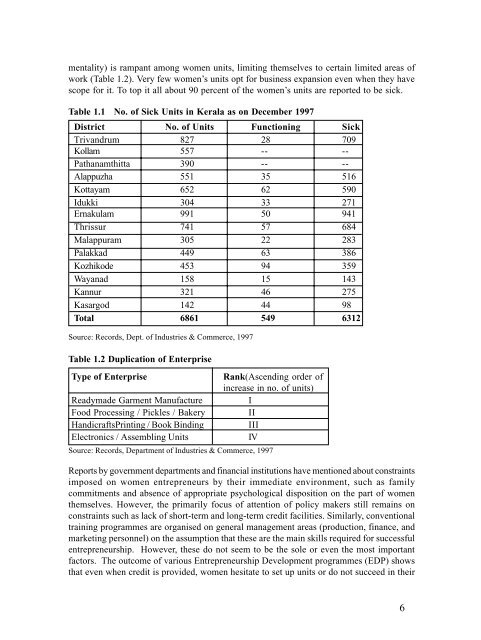Constraints on Women Entrepreneurship Development in Kerala: An ...
Constraints on Women Entrepreneurship Development in Kerala: An ...
Constraints on Women Entrepreneurship Development in Kerala: An ...
You also want an ePaper? Increase the reach of your titles
YUMPU automatically turns print PDFs into web optimized ePapers that Google loves.
mentality) is rampant am<strong>on</strong>g women units, limit<strong>in</strong>g themselves to certa<strong>in</strong> limited areas of<br />
work (Table 1.2). Very few women’s units opt for bus<strong>in</strong>ess expansi<strong>on</strong> even when they have<br />
scope for it. To top it all about 90 percent of the women’s units are reported to be sick.<br />
Table 1.1 No. of Sick Units <strong>in</strong> <strong>Kerala</strong> as <strong>on</strong> December 1997<br />
District No. of Units Functi<strong>on</strong><strong>in</strong>g Sick<br />
Trivandrum 827 28 709<br />
Kollam 557 -- --<br />
Pathanamthitta 390 -- --<br />
Alappuzha 551 35 516<br />
Kottayam 652 62 590<br />
Idukki 304 33 271<br />
Ernakulam 991 50 941<br />
Thrissur 741 57 684<br />
Malappuram 305 22 283<br />
Palakkad 449 63 386<br />
Kozhikode 453 94 359<br />
Wayanad 158 15 143<br />
Kannur 321 46 275<br />
Kasargod 142 44 98<br />
Total 6861 549 6312<br />
Source: Records, Dept. of Industries & Commerce, 1997<br />
Table 1.2 Duplicati<strong>on</strong> of Enterprise<br />
Type of Enterprise Rank(Ascend<strong>in</strong>g order of<br />
<strong>in</strong>crease <strong>in</strong> no. of units)<br />
Readymade Garment Manufacture I<br />
Food Process<strong>in</strong>g / Pickles / Bakery II<br />
HandicraftsPr<strong>in</strong>t<strong>in</strong>g / Book B<strong>in</strong>d<strong>in</strong>g III<br />
Electr<strong>on</strong>ics / Assembl<strong>in</strong>g Units IV<br />
Source: Records, Department of Industries & Commerce, 1997<br />
Reports by government departments and f<strong>in</strong>ancial <strong>in</strong>stituti<strong>on</strong>s have menti<strong>on</strong>ed about c<strong>on</strong>stra<strong>in</strong>ts<br />
imposed <strong>on</strong> women entrepreneurs by their immediate envir<strong>on</strong>ment, such as family<br />
commitments and absence of appropriate psychological dispositi<strong>on</strong> <strong>on</strong> the part of women<br />
themselves. However, the primarily focus of attenti<strong>on</strong> of policy makers still rema<strong>in</strong>s <strong>on</strong><br />
c<strong>on</strong>stra<strong>in</strong>ts such as lack of short-term and l<strong>on</strong>g-term credit facilities. Similarly, c<strong>on</strong>venti<strong>on</strong>al<br />
tra<strong>in</strong><strong>in</strong>g programmes are organised <strong>on</strong> general management areas (producti<strong>on</strong>, f<strong>in</strong>ance, and<br />
market<strong>in</strong>g pers<strong>on</strong>nel) <strong>on</strong> the assumpti<strong>on</strong> that these are the ma<strong>in</strong> skills required for successful<br />
entrepreneurship. However, these do not seem to be the sole or even the most important<br />
factors. The outcome of various <strong>Entrepreneurship</strong> <strong>Development</strong> programmes (EDP) shows<br />
that even when credit is provided, women hesitate to set up units or do not succeed <strong>in</strong> their<br />
6










